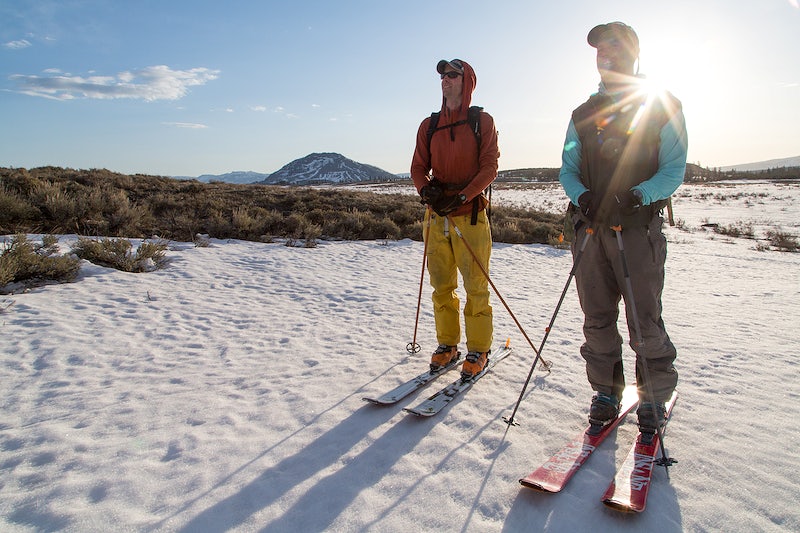Tips & Tricks to Get Started Snowshoeing

Winter time isn’t easy on hikers and campers. Getting to trailheads can be super dangerous, and a lot of proper preparation and gear is required to make the most of a winter adventure. That said, it’s still entirely possible and can be worthwhile for views that aren’t available year round. One of the best ways to experience that is via snowshoeing, and today we’ll break down why you should give it a shot and how to get started.

Why You Should Try Snowshoeing!
Put simply, it’s one of the easiest outdoor winter activities to learn, all you have to do is find your footing. It’s also a great, low-impact aerobic exercise that can scratch the itch for runners and hikers looking to extend their seasons. On top of that, it’s a fun social activity that’s enjoyable for all ages and abilities. It only requires a few basic techniques to master your step, use your poles and traverse different levels of incline.
Best of all, it’s inexpensive. There isn’t much to it besides the shoes themselves, winter attire and poles. If you’re unsure about your level of commitment, you can always rent poles and shoes at REI Co-Ops around the country. Find one near you here.

Gear to be Prepared
Since you’ll be working up a bit of a sweat, you should layer up with non-cotton garments because once cotton gets wet it starts to sap your body heat, causing you to chill up real quick. A great base layer would be something like American Backcountry’s very own Basic Performance Tee. Made of 100% spun polyester, it’s as comfortable as traditional cotton but delivers exceptional moisture-wicking performance. Shop our full Basic Performance collection in a wide range of colors and designs here!
For a midlayer, polyester fleece works, though we recommend soft-shell pants and a jacket because they’re good at retaining heat while being breathable. You’ll want your outer layer to be 100% water proof. A traditional snowboard or ski jacket may be a bit burly for this activity since you’re far less likely to fall over. Pit zips are an optional plus for a little extra ventilation.
Aside from mittens, a scarf and hat, the next most important thing will be gaiters to keep snow out of your boots. Snowshoes fit virtually any boot, and you’ll want yours to be insulated and waterproof.

When it comes to selecting snowshoes, there are a couple factors to consider: the terrain you’ll be hiking, maximum recommended load and type of snow. For example, powdery snow requires snowshoes with a large surface area so you can stay “afloat” over the snow. Trails that have compact, wet snow are easier navigated with smaller shoes - same goes for icy and steep terrain.
The three types of snowshoes are flat terrain, rolling terrain and mountain terrain. Flat terrain snowshoes are a great entry level pick, designed to comfortably navigate flat terrain, faring decently on mild rolling terrain as well. They feature a simple binding system, have modest traction but no heel lift for steep inclines. Rolling terrain snowshoes are better suited for inclines, but nothing too icy or steep. These have better traction, a sturdy but simple binding system, and some models come with slight heel lifts. If you’re just getting your feet wet, you probably won’t be starting out on any trails that mountain terrain snowshoes are geared for. With a high-end pricepoint, these models are built for intensely steep and icy terrain. Their features typically include: a sophisticated binding system to fit larger boots, aggressive crampon system for the best traction and a heel lift suited for any incline.
Poles also play a major role. It’s possible to go without them if you’re seasoned and traversing flatter terrain. If you’re just starting out then we recommend using them as it will make each step of the way a little less exerting and easier to balance. The steeper the terrain, the more important poles will be.

Basic Techniques
Flat terrain being the easiest to snowshoe, all you need to do is practice a wide stride to avoid stepping on the inside of your snowshoe frames. After your first day snowshoeing, you may find that your groin and hips may be a little achy because of this. A good general rule of thumb is to keep the tips of your shoes up with each motion, keeping the toes above the snowline.

As incline gets steeper, you’ll start to employ your toe or instep crampons more and more for better traction. Always keep your poles in front of you with your feet firmly planted in the snow. In powdery snow, do what’s called the Kick-Step technique - lift your foot and kick into the snow with the ball of your foot, leveling the angle of your shoe to be parallel to the slope. This is where a good pair of rolling or mountain terrain snowshoes will come in handy with their heel lifts. If this method ends up creating a deeper hole in the snow, then look for an alternate route.
This method won’t be applicable in compact snow on an incline. Here, you’ll have to rely on the traction of your crampons and poles.

When traversing downhill, keep your poles in front of you firmly planted with your body weight slightly back, knees relaxed and bent. Carefully plant your heel down, making each step a smooth motion. Extending your poles will help your balance on the way down as well. The steeper the slope, the farther back you want to keep your weight. If you think you’re going to start slipping, try to sit down to avoid falling off balance sideways.
–
As with every new activity (especially a winter sport), we recommend embarking with a guide or seasoned professional. They’ll be able to answer questions, provide feedback and give tips for success.
Let’s make the most of any backcountry winter wonderland this coming season!




Leave a comment